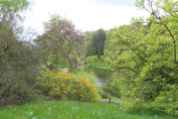My fifth great grandmother Dorothy Scott was born on 15 November 1765 at Betton Strange Hall, near Shrewsbury in Shropshire to Richard Scott (1731 – 1770) and Elizabeth Scott nee Gough (1735 – 1772). She had three older brothers.
In 1770, with Dorothy not yet five years old, her father died, and two years later her mother. I do not know who brought up Dorothy when she was orphaned.
On 20 January 1783, at the age of seventeen, Dorothy married Philip Champion Crespigny, a lawyer, forty-four years old; she was his fourth wife. Of the nine children by his previous wives, seven were living at the time of his marriage to Dorothy Scott.
Dorothy and Philip had four children, one of whom died in infancy. The polyphiloprogenitive Philip died, on 1 January 1803; he and Dorothy had been married for nearly 20 years.

On 27 March 1804 at St Swithin’s Church, Walcot, Bath, Dorothy married for a second time, to Sir John Keane (1757 – 1829).
Keane was an Irish Tory Member of Parliament, who had been made a baronet in 1801. In the Irish Parliament he represented Bangor from 1791 to 1897; Youghal from 1797 to 1800; and he represented Youghal in the House of Commons from 1801to 1806 and from 1807 to 1818. The ‘History of Parliament‘ notes that “evidence of his presence at Westminster is very thin”. “In February 1817 the chief secretary was informed that he was living at Southampton and should be asked to pay a visit to Westminster. On 15 April 1818 he turned up to vote with ministers on the Duke of Clarence’s Marriage Grant. He did not seek re-election that year.”
Dorothy and John Keane had one son, George (1805 – 1880). Keane had been married previously and had at least four children by his first wife. He died on 18 April 1829 at his house in the Royal Crescent, Bath.
The dowager Lady Keane died on 5 July 1837 at Malvern Wells, Worcestershire. Her death was registered at Upton upon Severn, six miles to the east. (New legislation concerning civil registration had come
into effect on 1 July 1837 and her death was one of the first to be registered under the Births and Deaths Registration Act 1836. The new law required that “within Three Days after the day of such Death…[notice should be given] to the Registrar of the District”.)

The death of the dowager Lady Keane was announced in several newspapers. The London ‘Morning Post‘ of Saturday, July 8, 1837 wrote: ‘Died: At Malvern, on the 5th inst., the Dowager Lady Keane, relict of Sir John Keane, Bart., of Bath’. The Worcester ‘Berrows Worcester Journal‘ of Thursday, July 13, 1837 had: ‘July 5th, at Malvern Wells, aged 72, the Dowager Lady Keane, relict of Sir John Keane, Bart., of the Crescent, Bath’.

The spring or well is named after Saint Anne, the maternal grandmother of Christ and the patron saint of many wells. The building housing the spring dates back to 1813.
Malvern Wells, where Lady Keane seems to have resorted after the death of her husband, was a spa town, whose water was thought for centuries to have beneficial properties. In 1817 an enthusiast named John Chambers published A General History of Malvern, embellished with plates, intended to comprise all the advantages of a Guide, with the important details of chemical, mineralogical and statistical information. In the 19th century Malvern became famous for the water cure, and it rapidly developed into to a busy town with many large hotels. Hydrotherapists promoted the cure, and the resort’s many well-known patients and patrons—one was Lord Lytton, who in 1845 published “Confessions of a Water-Patient“– contributed to Malvern’s renown.
Dorothy was buried with her second husband in St. Nicholas’ Churchyard, Bathampton, Somerset.

Related posts
- Philip Champion de Crespigny (1738 – 1803)
- Concerning her three children surviving with Philip:
- George: D is for Durham Light Infantry
- George (1783-1813) : D is for Durham Light Infantry
- Eliza (1784-1831) : G is for Gretna Green
- Charles Fox (1785-1875) : Charles Fox Champion de Crespigny (1785 – 1875)
- On the sale of her portrait by her great grandson: Great expectations – disappointed
Further reading
- Jupp, P. J. “KEANE, John (1757-1829), of Belmont, co. Waterford.” History of Parliament , The History of Parliament Trust, www.historyofparliamentonline.org/volume/1790-1820/member/keane-john-1757-1829.
Wikitree:







































